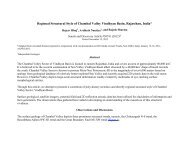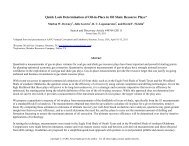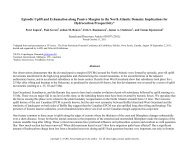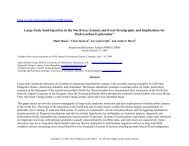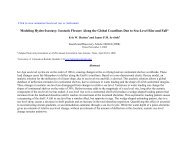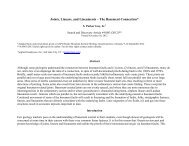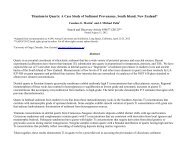Structural and Diagenetic Controls of a Fractured Carbonate Reservoir
Structural and Diagenetic Controls of a Fractured Carbonate Reservoir
Structural and Diagenetic Controls of a Fractured Carbonate Reservoir
Create successful ePaper yourself
Turn your PDF publications into a flip-book with our unique Google optimized e-Paper software.
<strong>Structural</strong> <strong>and</strong> <strong>Diagenetic</strong> <strong>Controls</strong> <strong>of</strong> a <strong>Fractured</strong> <strong>Carbonate</strong> <strong>Reservoir</strong> - Implications for Oil Deposit<br />
Development (A Case Study from the Zechstein <strong>of</strong> Pol<strong>and</strong>)*<br />
Andrzej Gasiewicz 1 , Zbigniew Mikolajewski 2 , Miroslaw Slowakiewicz 1 , <strong>and</strong> Maciej Tomaszczyk 1<br />
Search <strong>and</strong> Discovery Article #20131 (2012)<br />
Posted February 27, 2012<br />
*Adapted from oral presentation at AAPG International Conference <strong>and</strong> Exhibition, Milan, Italy, October 23-26, 2011<br />
1Polish Geological Institute, Warsaw, Pol<strong>and</strong> (mslo@pgi.gov.pl)<br />
2 Polish Oil <strong>and</strong> Gas Company, Pila, Pol<strong>and</strong><br />
Abstract<br />
In the northwest part <strong>of</strong> Pol<strong>and</strong>, in the Upper Permian (Zechstein) strata occur dolomitized carbonates (Main Dolomite, Ca2) in which<br />
14 oil deposits have been found so far. One <strong>of</strong> them is the Wysoka Kamienska Oil Field. The complicated Wysoka Kamienska<br />
structure is cut by NW-SE trending faults. Main Dolomite carbonates, which host the oil deposit, are characteristic <strong>of</strong> carbonate<br />
platform slope lith<strong>of</strong>acies built <strong>of</strong> laminated limy mudstones, dolostones <strong>and</strong> dolomitic biolaminites, which can be considered as<br />
source rocks.<br />
The maximum thickness <strong>of</strong> Ca2 pr<strong>of</strong>iles reaches 65 m. Almost 90% <strong>of</strong> the pr<strong>of</strong>iles have porosities 0.1-2% but in the last 10%<br />
representing upper parts porosities reach 23%. Permeability varies from >1 to 10 mD. Total organic content is from ca 0.5% to 1.25%<br />
<strong>and</strong> organic matter is sapropelic. Tiny clusters <strong>of</strong> fine grained bituminite occur in sapropelic streaks.<br />
Vitrinite reflectance (Ro) values measured in several lense-like carbonate grains syngenetic with the sediment bitumen vary from<br />
0.38-0.62% (mean 0.49%). This suggests low maturity kerogen <strong>and</strong> low hydrocarbon potential. Ro measured on redeposited grains <strong>of</strong><br />
vitrinite ranges from 0.79% to 1.85%. Values <strong>of</strong> Tmax are 414-430°C (close in biolaminites <strong>and</strong> lime mudstones) which suggests the<br />
final stage <strong>of</strong> microbial transformation <strong>of</strong> organic matter <strong>and</strong> initial stage <strong>of</strong> thermocatalytic changes.<br />
Crude oil has a density <strong>of</strong> 0.877 g/cm³, a viscosity <strong>of</strong> 40-50 cSt (35-44 cP) <strong>and</strong> contains 30-35% <strong>of</strong> the gasoline fraction, about 5%<br />
paraffins <strong>and</strong> about 1% sulfur. The accompanying gas contains up to 90% hydrocarbons <strong>and</strong> 5-9% nitrogen.
High porosities are related to fractures filled with oil. Fractures possibly developed by extension tectonics during the Zechstein <strong>and</strong><br />
were activated during Late Cretaceous/Palaeogene inversion <strong>of</strong> the Middle Polish Trough. Other porosity is in vugs which were<br />
developed at different stages <strong>of</strong> burial; most are related to late stage diagenesis <strong>and</strong> dissolution contemporaneous with fracturing <strong>of</strong> the<br />
carbonate reservoir. Vugs are occluded by late diagenetic anhydrite cement. The most important are therefore fractures in which oil is<br />
trapped. Hence the Wysoka Kamienska Oil Field is an example <strong>of</strong> a fractured carbonate reservoir.<br />
There are two concepts <strong>of</strong> oil origin: (1) in situ generation, <strong>and</strong> (2) migration from basinal parts. Based on data obtained, it is<br />
suggested that the oil deposit contains both partly syngenetic HCs <strong>and</strong> partly epigenetic (the latter related most possibly to fracturing).<br />
Selected References<br />
Dyjaczynski, K., B. Papiernik, T.M. Peryt, S. Protas, <strong>and</strong> R. Wagner, 2000, Mapa paleogeograficzna dolomitu głównego (Ca2)<br />
1 : 500 000, in M. Kotarba, (ed.) Bilans i potencjał węglowodorowy dolomite głównego basenu permskiego Polski. Archiwum<br />
PGNiG SA, Warszawa (in Polish).<br />
Mawson, M., <strong>and</strong> M. Tucker, 2009, High-frequency cyclicity (Milankovitch <strong>and</strong> millennial-scale) in slope-apron carbonates;<br />
Zechstein (Upper Permian), north-east Engl<strong>and</strong>: Sedimentology, v. 56/6, p. 1905-1936.<br />
Slowakiewicz, M., H. Kiersnowski, <strong>and</strong> R. Wagner, 2008, Correlation <strong>of</strong> the Middle <strong>and</strong> Upper Permian marine <strong>and</strong> terrestrial<br />
sedimentary sequences in Polish, German, <strong>and</strong> USA Western Interior Basins with reference to global time markers: Palaeoworld,<br />
v. 18/2-3, p. 193-211<br />
Slowakiewicz, M., <strong>and</strong> Z. Mikolajewski, 2011, Upper Permian main dolomite microbial carbonates as potential source rocks for<br />
hydrocarbons (W. Pol<strong>and</strong>): Marine <strong>and</strong> Petroleum Geology, v. 28/8, p. 1572-1591.<br />
Websites<br />
Blakey, Ron, online resource, Paleogeography <strong>and</strong> geologic evolution <strong>of</strong> Northern Pangaea: Middle Permian. Web accessed 27<br />
January 2012, http://cpgeosystems.com/index.html<br />
Ge<strong>of</strong>izyka Torun Geophysical Services, 1980, 2D seismic in Wysoka Kamienska, Pol<strong>and</strong>: Web accessed 27 January 2012,<br />
http://www.ge<strong>of</strong>izyka.pl/
<strong>Structural</strong> <strong>and</strong> diagenetic controls <strong>of</strong> a<br />
fractured carbonate reservoir –<br />
implications for oil deposit development (a<br />
case study from the Zechstein <strong>of</strong> Pol<strong>and</strong>)<br />
Andrzej Gąsiewicz 1 , Zbigniew Mikołajewski 2 ,<br />
Mirosław Słowakiewicz 1 , Maciej Tomaszczyk 1<br />
1 Polish Geological Institute, Polish Geological Survey, Pol<strong>and</strong><br />
2 Polish Oil <strong>and</strong> Gas Company (PGNiG SA), Pol<strong>and</strong>
PALAEOGEOGRAPHY<br />
Paleogeography after Blakey 2005 see Słowakiewicz et al. 2008)
Stratigraphy
BS – Bakevelia Sea<br />
Smith 1980, Mawson & Tucker 2009
Słowakiewicz & Mikołajewski 2011
Slope facies thickness<br />
Main Dolomite: 40-65 m<br />
Roker Fm.:~100 m<br />
Stassfurt Karbonat: 10-250 m
after Dyjaczyński et al. 2000<br />
Main Dolomite Ca2
Northern rim <strong>of</strong> the Main Dolomite carbonate platform in Pol<strong>and</strong> (after Dyjaczyński et al..<br />
2000; oil deposits after Buniak & Mikołajewski 2011)
W<br />
Zstr<br />
A2<br />
Z1<br />
Wysoka Kamieńska 2D seismic survey, Ge<strong>of</strong>izyka Toruń 1980<br />
E
Some facts<br />
Wysoka Kamieńska oil deposit discovered in<br />
1978 with W. Kamieńska-1<br />
reserves: 1.8 mln t, associated gas: 91% HC<br />
<strong>and</strong> 5-9% <strong>of</strong> nitrogen<br />
Density <strong>of</strong> crude oil: 0.859-0.877 g/cm3 Viscosity: 40-50 cSt (35-44cP)<br />
30-35% <strong>of</strong> the gasoline fraction<br />
5% paraffins<br />
1% sulfur
Almost 90% <strong>of</strong> the pr<strong>of</strong>iles have porosities 0.1-2%<br />
but in the last 10% representing upper parts<br />
porosities reach 23%.<br />
Permeability vary from >1 to 10 mD.
Slope lith<strong>of</strong>acies: northern margin<br />
Wysoka Kamieńska-8, 3085.8 m Wysoka Kamieńska-8, 3106.8 m
2 cm<br />
Wysoka Kamieńska-8, 3149.2 m<br />
Wysoka Kamieńska-8, 3091.8 m
Wysoka Kamieńska-8, 3070.8 m
3074 m<br />
3069.4 m<br />
Scale 0.25 mm<br />
3076.8 m<br />
3070 m
3107 m<br />
Scale 0.25 mm<br />
3110 m
Vitrinite reflectance measured in several<br />
lense-like carbonate grains: 0.38 to 0.62%<br />
(mean 0.49%)<br />
This suggests low maturity kerogen <strong>and</strong> low hydrocarbon<br />
potential<br />
Vitrinite reflectance measured on<br />
redeposited grains <strong>of</strong> vitrinite ranges from<br />
0.79 to 1.85%
1 2<br />
Wysoka Kamieńska-8, 3073.2 m Wysoka Kamieńska-8, 3070.8 m<br />
3 4<br />
Wysoka Kamieńska-8, 3073.2 m
T max = 414-430 o C (close in biolaminites<br />
<strong>and</strong> lime mudstones) what suggests final<br />
stage <strong>of</strong> microbial transformation <strong>of</strong><br />
organic matter <strong>and</strong> initial stage <strong>of</strong><br />
thermocatalytic changes.
TOC content is from ca 0.5% to 1.25%<br />
<strong>and</strong> organic matter is sapropelic.
Conclusions<br />
1. High porosities are related to fractures filled with oil.<br />
Fractures possibly developed by extension tectonics<br />
during the Zechstein <strong>and</strong> were activated during Late<br />
Cretaceous/Palaeogene inversion <strong>of</strong> the Middle Polish<br />
Trough.<br />
2. Other porosities come from vugs which were<br />
developed at different stages <strong>of</strong> burial. Most <strong>of</strong> them<br />
are related to late stage <strong>of</strong> diagenesis <strong>and</strong> dissolution<br />
contemporaneous with fracturing <strong>of</strong> the carbonate<br />
reservoir.<br />
3. Wysoka Kamieńska is a fractured carbonate reservoir.<br />
4. There are two concepts about oil origin: in situ<br />
generation <strong>and</strong> migration from basinal parts. It is<br />
suggested that the oil deposit contains both partly<br />
syngenetic HCs <strong>and</strong> partly epigenetic (the latter related<br />
to most possibly fracturing).
Acknowledgments<br />
Polish Oil <strong>and</strong> Gas Company (PGNiG SA) for<br />
providing materials <strong>and</strong> permission to use them





